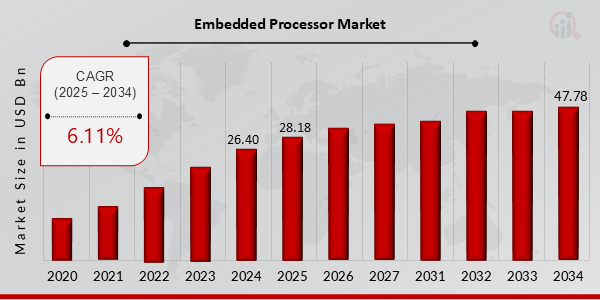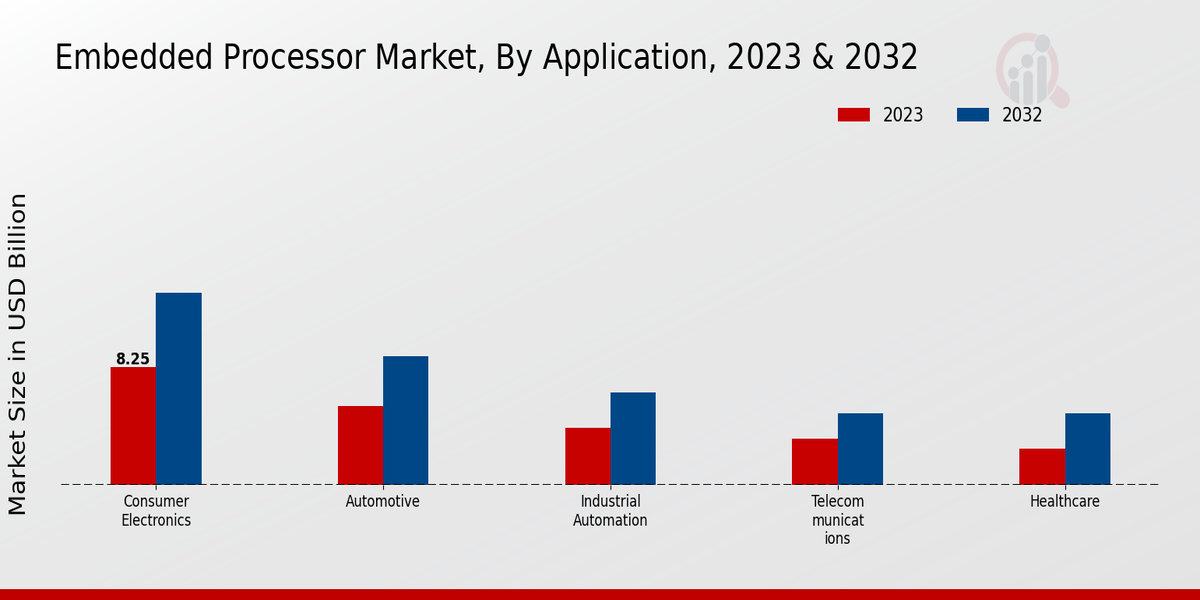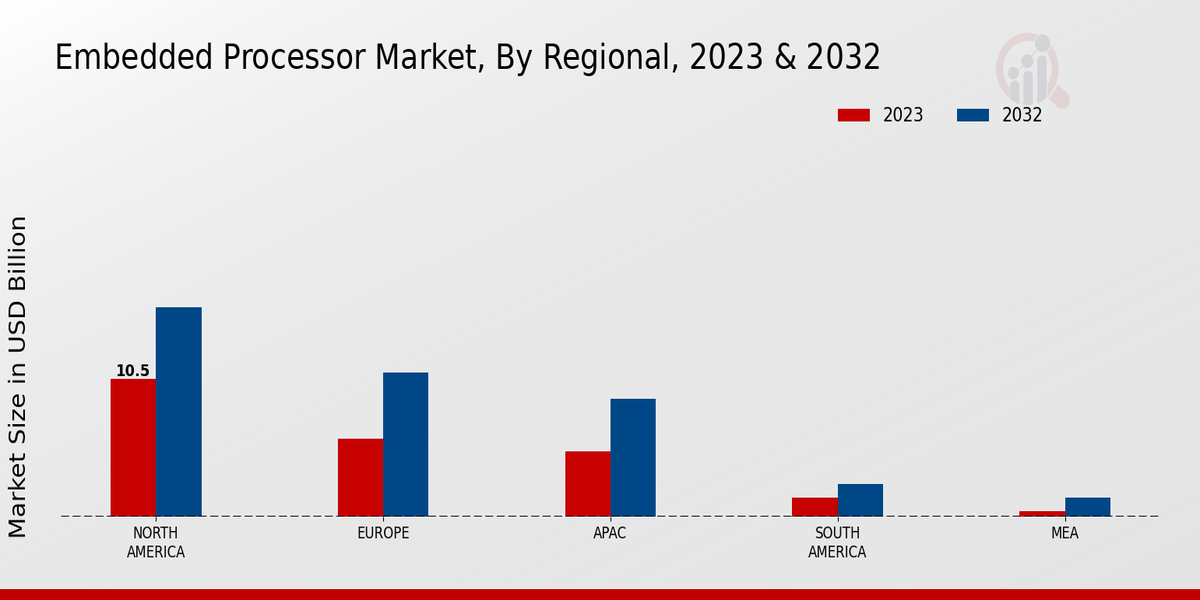Global Embedded Processor Market Overview
Embedded Processor Market Size was estimated at 26.40 (USD Billion) in 2024. The Embedded Processor Market Industry is expected to grow from 28.18 (USD Billion) in 2025 to 47.78 (USD Billion) till 2034, exhibiting a compound annual growth rate (CAGR) of 6.11% during the forecast period (2025 - 2034).
Key Embedded Processor Market Trends Highlighted
The Embedded Processor Market is experiencing significant growth driven by several key market drivers. The increasing demand for smart devices and the Internet of Things (IoT) is pushing manufacturers to enhance processing power while maintaining energy efficiency. As industries like automotive, healthcare, and consumer electronics embrace advanced technologies, the need for reliable and efficient embedded processors becomes critical. Additionally, the rising trend of automation across various sectors fosters a greater reliance on embedded systems, thus impacting the overall market positively. Opportunities in the embedded processor market remain vast.As technology advances, there is a growing focus on developing specialized processors that cater to specific applications, such as artificial intelligence and machine learning. Companies can explore avenues in integrating advanced security features into embedded systems, which are vital for safeguarding user data in connected devices. Moreover, as industries seek to lower power consumption while maximizing performance, research into new materials and architectures can lead to innovative embedded solutions. This presents an opportunity for companies to differentiate themselves in a crowded market. Recent trends also indicate a shift towards the use of multicore processors, enhancing performance and efficiency in embedded systems.The integration of machine learning capabilities into embedded processors is becoming more common, allowing devices to make decisions based on data. Additionally, the rise of edge computing is driving the demand for embedded processors that can perform tasks closer to data sources, reducing latency and improving response times. These trends demonstrate a dynamic market that is continuously evolving and adapting to meet the needs of various industries. As the embedded processor market progresses, it remains essential for businesses to keep up with these changes to capitalize on potential growth and innovation opportunities.

Source: Primary Research, Secondary Research, MRFR Database and Analyst Review
Embedded Processor Market Drivers
Rising Demand for Smart and Connected Devices
The surge in the adoption of smart and connected devices across various sectors is a significant driver for the Embedded Processor Market Industry. As technology continues to evolve, consumers are increasingly demanding devices that not only provide basic functionalities but also integrate advanced features such as connectivity, automation, and intelligence. This trend is particularly evident in industries such as consumer electronics, automotive, healthcare, and industrial automation.With the continuous innovation in Internet of Things (IoT) technologies, there is an upsurge in the development of devices that require reliable and efficient embedded processors. These processors are essential for managing data, processing functions, and ensuring seamless communication within smart devices. The evolution of smart home systems, wearable technology, and connected vehicles has further fueled this demand, thereby providing ample opportunities for growth within the embedded processor sector.Companies are investing in research and development to create processors that can handle complex tasks while maintaining energy efficiency. Moreover, the trend towards miniaturization and the need for low-power consumption embedded processors for portable devices create an attractive market condition for manufacturers. As a result, the Embedded Processor Market is expected to witness substantial growth driven by this increasing demand for smart and connected devices, making it one of the pivotal market drivers.
Growing Adoption of Artificial Intelligence
The integration of artificial intelligence (AI) into various applications is driving the demand for robust embedded processors in numerous industries. As AI continues to gain traction, the need for advanced processing capabilities and real-time data processing has increased. Embedded processors play a critical role in enabling AI functionalities, thereby enhancing automation and decision-making processes across different sectors. The Embedded Processor Market Industry is witnessing innovations that align with AI applications, ranging from industrial automation to consumer electronics, increasing market opportunities.
Advancements in Automotive Technology
The automotive industry is undergoing a transformation with the introduction of electric and autonomous vehicles, which rely heavily on embedded processing solutions. Advanced driver-assistance systems (ADAS), infotainment systems, and vehicle-to-everything (V2X) communication necessitate sophisticated embedded processors to ensure efficient operation and safety. The Embedded Processor Market Industry is expected to benefit from these technological advancements as manufacturers seek to enhance vehicle performance and safety features.
Embedded Processor Market Segment Insights:
Embedded Processor Market Application Insights
The Embedded Processor Market, with a projected overall market value of 23.45 USD Billion in 2023, shows significant potential across various applications. The market is poised for growth driven by advancements in technology and the increasing adoption of embedded systems in diverse sectors. Among the key applications, Consumer Electronics holds a majority share, valued at 8.25 USD Billion in 2023 and expected to increase to 13.5 USD Billion by 2032. This segment’s dominance is largely due to the growing demand for smart devices, including smartphones, smart TVs, and IoT gadgets, which require sophisticated processing capabilities for enhanced user experiences.Automotive applications are significant as well, with a valuation of 5.5 USD Billion in 2023 and projected to reach 9.0 USD Billion by 2032. The introduction of advanced driver-assistance systems (ADAS) and the shift towards electric vehicles (EVs) necessitate robust embedded processors, making this segment crucial for technological enhancement in the automotive industry. The Industrial Automation segment also plays a vital role, valued at 4.0 USD Billion in 2023 and expected to grow to 6.5 USD Billion by 2032. The increase in automation processes across manufacturing plants and facilities drives demand for embedded systems, which provide automation and control, improving efficiency and reliability.Telecommunications, valued at 3.2 USD Billion in 2023 and projected to achieve 5.0 USD Billion by 2032, highlights the need for high-performance processors in network infrastructure, particularly with the expansion of 5G technology and increasing data traffic. Equally, the Healthcare segment, valued at 2.5 USD Billion in 2023 and anticipated to double to 5.0 USD Billion by 2032, demonstrates the rising reliance on embedded systems for medical devices, remote monitoring, and telehealth services, emphasizing its importance in supporting healthcare advancements.The Embedded Processor Market statistics underscore substantial growth opportunities across these applications, driven by continuous technological innovations and evolving consumer demands. As industries increasingly integrate embedded processors into their products and services, the market reflects a trend toward a more interconnected and efficient future. Challenges in this space revolve around designing processors that can meet stringent regulatory standards, especially in automotive and healthcare applications. However, the ongoing exploration of embedded systems and their potential uses across various applications indicates substantial growth opportunities for stakeholders involved in the Embedded Processor Market industry.

Source: Primary Research, Secondary Research, MRFR Database and Analyst Review
Embedded Processor Market Processor Type Insights
The Embedded Processor Market is projected to reach a value of 23.45 billion USD in 2023, with a strong emphasis on the Processor Type segment for growth. This segment is characterized by various types of processors, including Microcontrollers, Microprocessors, Digital Signal Processors, Field-Programmable Gate Arrays, and System-on-Chip solutions, which together define the technology landscape for embedded applications. Microcontrollers play a pivotal role in consumer electronics and smart devices due to their ability to handle multiple tasks efficiently.Microprocessors dominate computing applications, offering significant processing power that is crucial for complex tasks in the automotive and industrial sectors. Digital Signal Processors are gaining traction, mainly in audio and video applications, where specialized processing capabilities are essential. Additionally, Field-Programmable Gate Arrays provide flexibility and customization, allowing developers to meet specific application needs. System-on-chip technologies are also on the rise, integrating various components into a single chip to enhance efficiency and reduce space requirements.The Embedded Processor Market segmentation outlines a dynamic landscape driven by innovative applications and increasing demand across different industries, thereby influencing market growth.
Embedded Processor Market Architecture Insights
The Embedded Processor Market is projected to reach a value of 23.45 billion USD in 2023, showcasing substantial growth potential driven by the increasing demand for embedded systems across various industries. The architecture segment is vital to this market and includes major categories such as ARM, x86, MIPS, and RISC-V. ARM architecture stands out due to its widespread adoption in mobile and IoT devices, emphasizing power efficiency and performance. The x86 architecture retains its prominence in high-performance computing environments and legacy systems, driving innovation in processing capabilities.MIPS architecture, although less dominant, plays a significant role in networking and consumer electronics, providing a solid alternative for low-cost embedded solutions. RISC-V, an open-source architecture, is gaining traction with its flexibility and adaptability, appealing to developers looking for customizable processor designs. Overall, the diverse architectures within the Embedded Processor Market segmentation underline the industry's robustness, while advances in technology continue to open up new opportunities and growth avenues.The market is expected to witness steady progress, with a forecasted increase in revenue across these architectures over the coming years.
Embedded Processor Market End-Use Insights
The Embedded Processor Market is poised for growth, with a projected valuation of 23.45 USD Billion in 2023. This market primarily segments into Personal, Commercial, and Industrial End Use, each playing a crucial role in driving market demand. The Personal segment is significant due to the increasing adoption of smart devices and wearables, which require efficient processing power for enhanced user experiences. The Commercial segment is also vital, as businesses leverage embedded processors for automation, improving operational efficiency and overall productivity.Additionally, the Industrial segment dominates, driven by the need for advanced manufacturing processes and integration of IoT technologies in various sectors. Collectively, these insights showcase the dynamic landscape of the Embedded Processor Market, where trends such as automation, smart technology proliferation, and IoT evolution continue to create opportunities and challenges, reflecting the ongoing market growth and development. Overall, the detailed examination of this End-use segmentation illustrates its importance in the broader context of Embedded Processor Market revenue generation and competitive positioning.
Embedded Processor Market Regional Insights
The Embedded Processor Market is experiencing substantial growth within its regional segments, structured to provide valuable insights into market dynamics. In 2023, North America leads with a market valuation of 10.5 USD Billion, representing a majority holding in the sector, driven by advancements in consumer electronics and automotive applications. Following closely, Europe holds a significant position with a valuation of 6.0 USD Billion, attributed to its strong manufacturing base and increasing demand for embedded systems. The APAC region, valued at 5.0 USD Billion in 2023, is recognized for its burgeoning electronics industry, making it a key player in the Embedded Processor Market.South America and MEA account for smaller portions of the market, with valuations of 1.5 USD Billion and 0.45 USD Billion respectively in 2023, often facing challenges due to infrastructure and economic fluctuations. The diverse landscape across these regions highlights the unique drivers and challenges faced in the Embedded Processor Market segmentation, providing opportunities for growth and innovation. As this market evolves, the regional distributions underscore the importance of targeted strategies to harness growth across various embedded processor applications.

Source: Primary Research, Secondary Research, MRFR Database and Analyst Review
Embedded Processor Market Key Players and Competitive Insights:
The Embedded Processor Market has become increasingly competitive due to the rapid advancements in technology and the growing demand for innovation across various industries. Embedded processors are integral to a wide range of applications, from consumer electronics to automotive systems, enabling increased functionality and efficiency in devices. As a result, numerous companies are vying for market leadership, employing strategies such as diversification of product offerings, enhancement of performance capabilities, and expansion into emerging markets. This competitiveness is further intensified by the need for processors to be energy-efficient and cost-effective, leading to continuous research and development efforts aimed at meeting the evolving requirements of manufacturers and developers.Atmel stands out in the Embedded Processor Market for its extensive range of microcontrollers that cater to various applications, particularly in the industrial, automotive, and consumer electronics sectors. The company's strength lies in its innovative architectures and the ability to deliver reliable solutions that integrate seamlessly within a diverse ecosystem of devices. Atmel's focus on low power consumption and high performance has allowed it to capture a significant market share, appealing to a broad customer base across the globe. Additionally, its strong commitment to customer support and tailored solutions further solidifies its presence in the market, making it a preferred choice for many companies seeking robust embedded processing platforms.ARM Holdings has established itself as a major player in the Embedded Processor Market, renowned for its powerful architecture and design of microprocessors. The company's technology is synonymous with energy-efficient performance, allowing for exceptional computational capabilities without compromising battery life, which is crucial for mobile and IoT applications. ARM Holdings benefits from a unique licensing model that enables a vast array of manufacturers to adopt and implement its designs within their products, fostering innovation at an unprecedented scale. The extensive ecosystem of partners and developers that ARM supports enhances its competitive edge by ensuring that its embedded processors remain at the forefront of technology advancements, catering to the growing demands for smarter and more capable devices across various sectors.
Key Companies in the Embedded Processor Market Include:
- Atmel
- ARM Holdings
- Intel
- Texas Instruments
- STMicroelectronics
- Qualcomm
- Infineon Technologies
- Cypress Semiconductor
- Mediatek
- Analog Devices
- NXP Semiconductors
- Broadcom
- Samsung Electronics
- Renesas Electronics
- Microchip Technology
Embedded Processor Market Industry Developments
Recent developments in the Embedded Processor Market indicate a significant surge in the demand for advanced processing solutions, driven by the increasing integration of IoT applications, automotive technologies, and smart devices. Companies like ARM Holdings are expanding their portfolio to support the development of AI-driven applications. Intel has also announced collaborations aimed at enhancing edge computing capabilities. Meanwhile, Texas Instruments and STMicroelectronics are investing in next-generation microcontrollers to meet the growing needs of the automotive and industrial sectors. Qualcomm is making strides in 5G connectivity, impacting embedded systems in telecommunications.In terms of mergers and acquisitions, Microchip Technology's acquisition of Microsemi has been highlighted as a pivotal move to broaden its embedded product offerings. Broadcom's endeavor to acquire additional semiconductor assets is noteworthy as well, aligning with its strategy to enhance its embedded processor capabilities. Market valuations of companies like Infineon Technologies and NXP Semiconductors are experiencing growth due to rising demand for secure and efficient embedded solutions across diverse industries. Such trends signify a robust future for the Embedded Processor Market with an emphasis on innovation and technological advancement.
Embedded Processor Market Segmentation Insights
Embedded Processor Market Application Outlook
- Consumer Electronics
- Automotive
- Industrial Automation
- Telecommunications
- Healthcare
Embedded Processor Market Processor Type Outlook
- Microcontroller
- Microprocessor
- Digital Signal Processor
- Field-Programmable Gate Array
- System-on-Chip
Embedded Processor Market Architecture Outlook
Embedded Processor Market End Use Outlook
- Personal
- Commercial
- Industrial
Embedded Processor Market Regional Outlook
- North America
- Europe
- South America
- Asia Pacific
- Middle East and Africa
|
Report Attribute/Metric
|
Details
|
|
Market Size 2024
|
USD 26.40 Billion
|
|
Market Size 2025
|
USD 28.18 Billion
|
|
Market Size 2034
|
USD 47.78 Billion
|
|
Compound Annual Growth Rate (CAGR)
|
6.11% (2025-2034)
|
|
Base Year
|
2024
|
|
Market Forecast Period
|
2025-2034
|
|
Historical Data
|
2020-2023
|
| Market Forecast Units |
USD Billion |
| Key Companies Profiled |
Atmel, ARM Holdings, Intel, Texas Instruments, STMicroelectronics, Qualcomm, Infineon Technologies, Cypress Semiconductor, Mediatek, Analog Devices, NXP Semiconductors, Broadcom, Samsung Electronics, Renesas Electronics, Microchip Technology |
| Segments Covered |
Application, Processor Type, Architecture, End Use, Regional |
| Key Market Opportunities |
Increased IoT device integration, Growth in automotive electronics, Rising demand for AI applications, Expansion of smart home devices, Advancements in industrial automation |
| Key Market Dynamics |
Growing IoT applications, Increasing automotive electronics, Rising demand for smart devices, Advancements in semiconductor technology, Expanding industrial automation |
| Countries Covered |
North America, Europe, APAC, South America, MEA |
Frequently Asked Questions (FAQ) :
The Embedded Processor Market is expected to be valued at 47.78 USD Billion by 2034.
The Embedded Processor Market is projected to have a CAGR of 6.11% from 2025 to 2034.
North America holds the largest market share in the Embedded Processor Market with a value of 10.5 USD Billion in 2023.
The Consumer Electronics segment is valued at 8.25 USD Billion in 2023.
The Automotive application segment is expected to reach a market size of 9.0 USD Billion by 2032.
The Industrial Automation segment is valued at 4.0 USD Billion in 2023.
Key players in the Embedded Processor Market include Atmel, ARM Holdings, Intel, Texas Instruments, and Qualcomm.
The Healthcare application segment is anticipated to reach a market size of 5.0 USD Billion by 2032.
The APAC region is expected to grow from 5.0 USD Billion in 2023 to 9.0 USD Billion by 2032.
The Telecommunications segment is valued at 3.2 USD Billion in 2023.

















